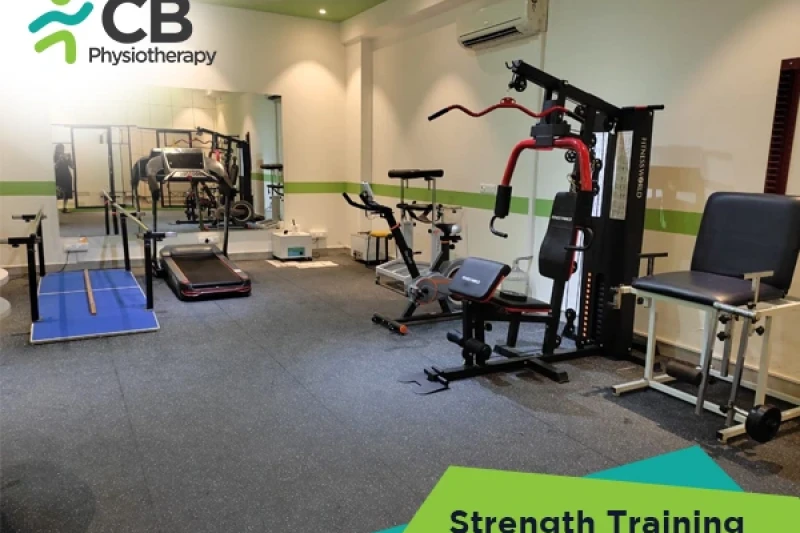
Strengthening is the ability of the muscles to produce tension. This tension is responsible to stabilize and mobilize the bones of the body. Strengthening is the exercise training that aims to increase muscle strength. It is the process of maintaining health at any age. Strength training can be done for de-conditioning, to increase overall strength, or for bodybuilding.
To help build strength, frequency of strength training to get a muscle-building effect and targeting a muscle group every 48 – 72 hours is all that is necessary. Maintenance of muscle strength will occur by performing a minimal resistance exercise. The progression of the weight depends upon how the individual feels the next day.
The repetitions and sets of weight lifts change the overall effect on the body. Fatigue occurs during and after weight training but needs to be gentle fatigue with each session.
Strength
Developing strength involves lifting 1-8 repetitions, 1 to 8 sets with 30 seconds to a few minutes, and rest intervals in between the sets. These exercises increase muscle strength to do everyday work and activities.
Muscle mass
Training to develop muscle mass can be achieved by lifting weights, with repetitions of 8-12 times and 3 – 5 sets and only for 30 seconds to several minutes rest in-between sets.
Endurance
To increase endurance, fewer intensity exercises for a longer period such as running or cycling are done. These exercises are beneficial for individuals who do physical work for several hours during the day. Endurance training is a sub-maximal training thus the individual needs to do exercises with weights e.g. 12 or more repetitions, with more sets, and short rest.
Power
Power training is explosive movement training, a process to recruit muscle fibers. This can be achieved by sub-maximal loads of 1-8 repetitions, 1 to 8 sets with complete rest in-between each set with speed or short duration of lifting time. Care should be taken as power exercise can result in a high risk of injury. These are short-duration exercises with maximum intensity. Such types of exercises can be done by weightlifters or sprinters develop. These exercises are ideal for workers who have to lift heavy loads.
Strengthening can be done with a wide variety of equipment. Physiotherapists generally prefer:
1. Free weights, dumbbells, or weight cuffs.
2. Elastic bands, Thera-bands, or tubes
3. Quadriceps table with weights
4. Shoulder wheel with resistance
5. Handgrip exerciser
6. Hand gym kit board
7. Static cycle with adjustable intensity
8. Ankle pedal with adjustable intensity
9. Multi-station home gym
10. Electrical muscle stimulator
11. Own body weight can also be used to strengthen muscles while push-ups, squat planks, and sit-ups, are some examples of exercises that do not require equipment.
Avoiding DOMS
Delayed onset muscle soreness or DOMS, is a phenomenon where a body feels pain after intensive exercise 24-48 hours following the exercise. There are some easy ways to minimize or avoid DOMS following training by a well-planned program as well as appropriate recovery after any training regime.
To reduce DOMS -Start slowly with plenty of rest, proper technique, and greater repetitions with gradual overloading. All these steps are very important in building better strength, using appropriate muscles, and reducing injuries.
Once the individual is comfortable with the exercises, increase the loads and decrease the repetitions and rest periods.
Recovery
Recovery encompasses many elements and diet is one of them. When starting to strengthen for the first time, after injury, or after some time off, remember to start gradually. Poor recovery leads to an increased risk of injury. Recovery encompasses many elements and some of them are:
1. Timing training loads
2. Stretching
3. Sleep,
4. Massage, etc.
Training a muscle every day is not always best, we need to target a muscle group every 48-72 hours to increase strength. Both passive and active recovery should be followed. Active recovery is performing a gentle exercise that moves the muscles without pushing them to fatigue, for example, light intensity exercise, light walk or a swim, etc
Passive methods include rest, massage and cryotherapy, thermotherapy, etc
If recovery is adequate, then the individual can return to exercising but if there is pain that is lasting following any exercise, then it is best to seek the advice of a physiotherapist as he has a better understanding of recovery.
Patients who want to increase the strength of specific muscles or group of muscles can benefit from strengthening exercises. After an injury, the patient whose muscle is injured, to rebuild muscle strength, and mass strengthening exercises are helpful. In some cases there is decreased growth due to delayed milestones in children, strengthening exercises can be done to enhance the growth. These exercises can even decrease energy expenditure as muscles are more efficient and thus improve functionality, therefore, reducing the risk of injury and making the individual less prone to falls and fractures.
Select your City to find & connect with our experts regarding Physiotherapy for Strength Training